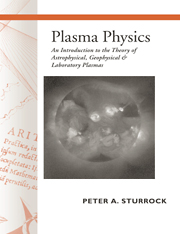Book contents
- Frontmatter
- Contents
- Preface
- 1 Introduction
- 2 Basic concepts
- 3 Orbit theory – uniform fields
- 4 Adiabatic invariants
- 5 Orbit theory
- 6 Electromagnetic waves in a cold electron plasma
- 7 Electromagnetic waves in an electron-ion plasma
- 8 Two-stream instability
- 9 Electrostatic oscillations in a plasma of nonzero temperature
- 10 Collision theory
- 11 MHD equations
- 12 Magnetohydrodynamics
- 13 Force-free magnetic-field configurations
- 14 Waves in MHD systems
- 15 Magnetohydrodynamic stability
- 16 Variation principle for MHD systems
- 17 Resistive instabilities
- 18 Stochastic processes
- 19 Interaction of particles and waves
- Appendix A Units and constants
- Appendix B Group velocity
- Appendix C Amplifying and evanescent waves, convective and absolute instability
- References
- Author index
- Subject index
18 - Stochastic processes
Published online by Cambridge University Press: 05 June 2012
- Frontmatter
- Contents
- Preface
- 1 Introduction
- 2 Basic concepts
- 3 Orbit theory – uniform fields
- 4 Adiabatic invariants
- 5 Orbit theory
- 6 Electromagnetic waves in a cold electron plasma
- 7 Electromagnetic waves in an electron-ion plasma
- 8 Two-stream instability
- 9 Electrostatic oscillations in a plasma of nonzero temperature
- 10 Collision theory
- 11 MHD equations
- 12 Magnetohydrodynamics
- 13 Force-free magnetic-field configurations
- 14 Waves in MHD systems
- 15 Magnetohydrodynamic stability
- 16 Variation principle for MHD systems
- 17 Resistive instabilities
- 18 Stochastic processes
- 19 Interaction of particles and waves
- Appendix A Units and constants
- Appendix B Group velocity
- Appendix C Amplifying and evanescent waves, convective and absolute instability
- References
- Author index
- Subject index
Summary
In previous chapters, we have studied the behavior of charged particlesi using various approximations, in given electric and magnetic field configurations. For instance, we have studied waves in a medium that is assumed to be homogeneous and static. In reality, an astrophysical plasma (such as the solar wind) is neither homogeneous nor static. Furthermore, we have only incomplete information about the structure and time-evolution of the medium. Another important class of problems involves systems that are mildly unstable, in which perturbations grow from some initial small level to a finite but significant level. An example of such a situation is provided by the study of the growth of plasma oscillations in the quasilinear approximation (see, for instance, Drummond and Pines, 1962, or Nicholson, 1983).
In problems such as these, we must develop procedures for representing and perhaps calculating the fluctuations that arise in a plasma. In many cases, we can conveniently represent these fluctuations as a superposition of waves (normal modes) in the plasma. However, the individual particles in such a plasma may behave in a manner that differs in important respects from the behavior of particles in the simpler situations that we have studied so far.
In discussing collision theory, we took account of the fact that a plasma is highly random at the microscopic level that is relevant for the discussion of binary collisions, etc. We now introduce the concept that the plasma may also be random on a macroscopic level, and we study the implications of such randomness.
- Type
- Chapter
- Information
- Plasma PhysicsAn Introduction to the Theory of Astrophysical, Geophysical and Laboratory Plasmas, pp. 288 - 300Publisher: Cambridge University PressPrint publication year: 1994

